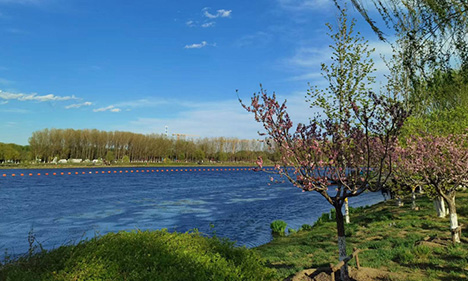Zimbabwe seeks to learn from China's experience as it marks 42 years of independence
HARARE, April 18 (Xinhua) -- Zimbabwe is seeking to modernize and industrialize its economy in a bid to attain an upper-middle-income status by 2030, with China's experience and help expected to contribute to the realization of that goal.
As Zimbabwe marks 42 years of independence on Monday, April 18, its relations with China, which date back to Zimbabwe's independence struggle, remain at an all-time high.
The southern African nation is increasingly looking to China's unprecedented developmental trajectory to achieve an empowered and prosperous society before its 50th anniversary in 2030.
As an initial step toward the attainment of its Vision 2030, launched in 2018 to modernize and industrialize its economy, the government adopted the Transitional Stabilization Plan (TSP) (2018-2020), the National Development Strategy 1 (NDS) (2021-2025) and the National Development Strategy 2 (2026-2030).
The TSP is a short-term policy focused on laying the foundation to stabilize the economy, which was characterized by spiraling annual inflation.
Taking a note of China's five-year plans, which are a series of social and economic development initiatives since 1953, the NDS is aimed at realizing Vision 2030, while simultaneously addressing the global Sustainable Development Goals.
Donald Rushambwa, researcher at the Harare-based China-Africa Economic and Culture Exchange Research Center, said China offers tangible lessons to Zimbabwe in its quest to transform the economy.
He said one of the advantages of China's modernization drive was that it was recent while that of the West predated World War II.
"We would like to take an approach whereby we know that this place (China) 44 years ago was just like us, but now they are different," Rushambwa told Xinhua. "So, at least there is a track record of how they did it as opposed to Britain and America which were modernized by even World War II."
Unlike Western countries whose development was characterized by exploitation, Rushambwa said, China has prospered peacefully.
IN PURSUIT OF A COMMUNITY OF SHARED FUTURE
Apart from providing a model for sustainable development, Chinese investments have been key in Zimbabwe's quest to industrialize.
Following the imposition of sanctions by Western countries at the turn of the millennium, China has stood firmly by Zimbabwe's side.
To date, China remains Zimbabwe's biggest foreign investor, with investments from the Asian country ranging from agriculture, mining and communications to the energy sector.
Trade between the two countries reached close to 1.9 billion U.S. dollars in 2021, a 35 percent jump from the 2020 figures, according to a release by Zimbabwe National Statistics Agency.
Increased economic engagement between the two sides has seen China making notable investments in Zimbabwe's manufacturing sector.
Through cooperation with China, last year Zimbabwe for the first time started assembling computers, tablets and other technological gadgets locally, following the establishment of the Zimbabwe Technology Company (ZITCO).
ZITCO, a joint venture between the government, Chinese firm Inspur, and state-owned telecommunications firm TelOne, has the capacity to produce 150,000 gadgets annually.
In the transportation sector, a joint venture between local automobile companies and a Chinese bus manufacturer will start assembling buses in Zimbabwe this year.
The partnership between Amalgamated Bus Industries, Quest Motors Manufacturing, AVM Africa, and China's Zhongtong Buses is targeting to assemble 500 buses in Zimbabwe annually.
Considering that capacity-building is an instrumental ingredient toward the creation of an empowered and prosperous society, China has over the years provided thousands of scholarships to Zimbabwean students to pursue their studies in various fields.
REGAINING BREADBASKET STATUS
The government identifies agriculture as the engine for economic growth and recognizes the need for large-scale investments in the sector through the adoption of smart technologies to maximize agricultural productivity.
In this regard, China has been assisting Zimbabwe to improve the production of crops such as tobacco by imparting valuable knowledge and technology transfer.
The China-aided Agricultural Technology Demonstration Center, near Harare, which promotes and showcases high-yield farming, latest agricultural machinery and irrigation technology, and overall Sino-Zimbabwean agricultural cooperation, has trained more than 3,000 local students over the past 10 years.
In tobacco farming, China is also playing a pivotal role. Demand from China and support from Chinese company Tianze have boosted Zimbabwe's tobacco sector.
Tianze, a subsidiary of China Tobacco International, started tobacco contract farming in Zimbabwe in 2005, when the country's tobacco output kept falling, to a low of 48 million kg in 2008.
Through its support, Zimbabwe's tobacco output has rebounded, reaching 210 million kg in 2021.
Counting on increased demand and support from China, the government is spearheading the Tobacco Value Chain Transformation Plan that aims at transforming Zimbabwe's tobacco value chain into a 5 billion U.S. dollar industry by 2025.
ACCESS TO PRECIOUS COMMODITY
To ensure that Zimbabweans have access to clean water, and to provide water for irrigation as a way to address climate change-induced droughts, the government is investing in dam construction, with Chinese firms like Sinohydro and China International Water and Electric Corporation (CWE) undertaking some major projects.
The CWE has made notable progress in building the Gwayi-Shangani Dam, in the Matebeleland region, which is set to be Zimbabwe's third-largest.
The government hopes that upon completion, the dam will help to end perennial water shortages in the second largest city of Bulawayo and surrounding areas.
To complement local efforts to tackle water challenges, the Chinese government has also been drilling boreholes in some of Zimbabwe's dry regions. So far, about 1,000 boreholes have been providing relief to water-deprived communities in six rural provinces.
Construction and engineering giant China Jiangxi International Economic and Technical Cooperation Co., Ltd. (CJIC) has been contracted to undertake the drilling project since 2012.
LAYING FIRM FOUNDATIONS
As a foundation and catalyst for economic development, infrastructure development has been identified as a major pillar toward the realization of Vision 2030.
A number of infrastructure construction projects funded by China are either underway or have since been completed.
Major infrastructural projects include the expansion of international airports, upgrading of telecommunications networks, the construction of a pharmaceutical warehouse in Harare, and the construction of a new Parliament building just outside Harare.
Progress has also been made in the energy sector, with Chinese-funded projects being implemented as the nation pushes ahead with its target to become energy self-sufficient and a net exporter by 2023.
Energy projects funded by China include the expansion of the Kariba South Hydro Power Station by 300 MW and the expansion of Hwange Thermal Power Station by 600 MW.
Zimbabwe has also turned to China to diversify its energy sources.
Shanghai Energy Exploration (SEE), a Chinese company exploring coal bed methane in north-western Zimbabwe, will start a pilot gas production project for power generation in 2024.
Photos
Related Stories
- Chinese community offers scholarships to Zimbabwean students
- Feature: Zimbabwean students chase their dreams by learning Chinese
- Investigation debunks defamation story on Chinese mining investment in Zimbabwe
- Chinese assistance helps Zimbabwe fight against pandemic, develop economy
- Feature: Zimbabwean artists to participate in Beijing International Art Biennale
Copyright © 2022 People's Daily Online. All Rights Reserved.










